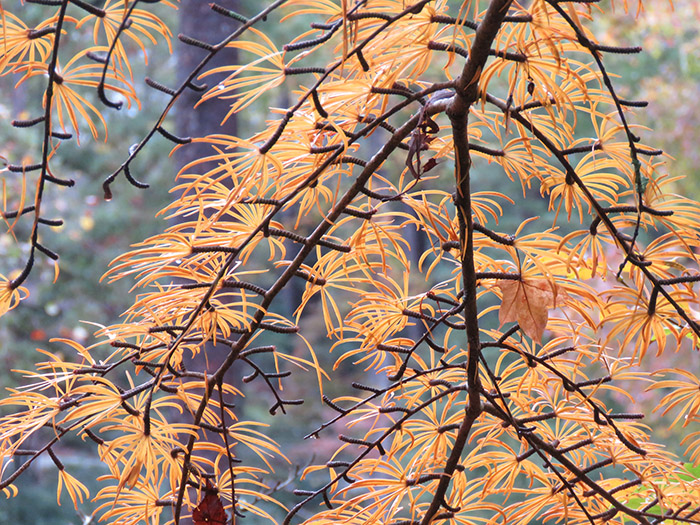
Photo by Sue Lannon.
Botanical name: Pseudolarix amabilis
Common name: Golden larch
Family name: Pinaceae (Pine family)
Native range: Southeastern China
Location in Duke Gardens: Culberson Asiatic Arboretum
USDA Hardiness Zones: 4-7
Conifers are generally evergreen, but there are a handful of exceptions with wonderful fall color, including the golden larch (Pseudolarix amabilis). As its scientific name suggests, this species is commonly mistaken for the more widespread true larches (Larix spp.) which are superficially similar in appearance. However, you are unlikely to encounter the two trees growing in the same place, as the golden larch can be grown in regions too hot and humid for true larches to thrive, including central North Carolina.
While Golden larch is beautiful at a distance, it is also striking up close thanks to the distinctive tufts of needles protruding from its branches like a sea anemone in a Dr. Seuss storybook. As the days shorten and the temperatures drop, its green needles turn a brilliant gold before falling, leaving short, stubby stumps behind. In the spring, unwieldly, club-like male cones emerge in thick clusters on the terminal shoots to spread their pollen on the wind. Successful fertilization makes way for spiky female cones that mature later in the year.
Golden larch is slow-growing, making it an attractive plant for bonsai. If left to its own devices, it will eventually mature into a large tree of considerable size at 30-40 feet tall. There are also several dwarf cultivars that remain compact for smaller gardens and urban landscapes.
The golden larch specimen in the Culberson Asiatic Arboretum is especially amabilis (Latin for “lovely”) right now, but it’s not the only deciduous conifer you’ll find here at Duke Gardens. Keep an eye out throughout October and November for a brilliant seasonal color shift in the dawn redwood (Metasequoia glyptostroboides) and bald cypresses (Taxodium distchum) in the Historic Gardens together with more familiar deciduous species like oaks and maples.
